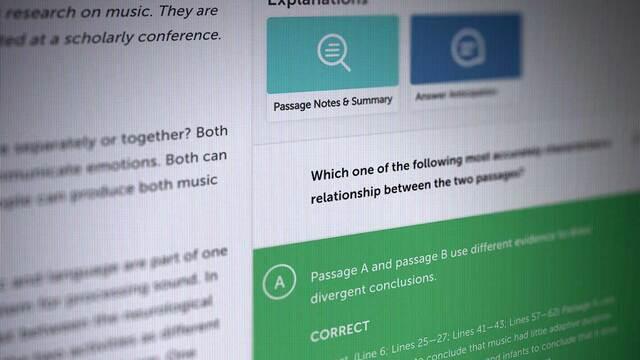We all learn differently, so some of us need a slightly different approach to get the most out of our LSAT studies. In this series, we’ll cover LSAT techniques that work particularly well for visual learners. Rather than learning and memorizing rules, these techniques will put your pencil and paper to work, allowing you to map out and visualize the correct answer.
Few Logical Reasoning concepts strike fear into LSAT-takers’ hearts quite like necessary and sufficient assumptions. These assumptions show up on what LSATMax calls Strengthen with a Necessary Premise and Strengthen with a Sufficient Premise questions. For many of us, this is where the Logical Reasoning section gets untenably abstract and heady. The visual learners among us don’t exactly thrive when things get abstract and heady — we prefer to see our work in front of us.
But for Strengthen with a Sufficient Premise questions, we visual learners can put our scratch paper to use to find the correct answer. This method can take us visual learners out of the cobweb-strewn inner recesses of our heads and help us solve Strengthen with a Sufficient Premise questions with good old-fashioned pencils and paper.
A Quick Aside to Define Sufficient Premises/Assumptions
But before we get into the technique to map out the correct answer to Strengthen with a Sufficient Premise questions (SwSPQs), we’ll need to define sufficient premises/assumptions. SwSPQs ask us to identify the answer choice that is a “sufficient assumption” or “sufficient premise.” For SwSPQs, the question stems will often say, “Which one of the following, if assumed, allows the conclusion to be properly inferred?” or, “Which one of the following assumptions enables the conclusion to follow logically?”*
*A quick aside within the quick aside: I increasingly hear instructors and test-takers that you can identify SwSPQs by the word “assumed” alone. As with most short-cut-y advice on the LSAT, this tidbit is misleading. A SwSPQ doesn’t have to use the word “assumed” (“Which one of the following, if true, allows the conclusion to be properly inferred?”). And there’s nothing stopping a regular Strengthen or Weaken question from using that word (“Which one of the following, if assumed, most strengthens/weakens the above argument?”). A Paradox question could even use that word (“Which one of the following, if assumed, most resolves the apparent paradox?”). To avoid missing or misidentifying some SwSPQs, look for an answer choice that asks us to add a statement (“if assumed,” “if true,” “assumption”) that will make the conclusion valid (“properly inferred,” “follow logically”).
To conceptually understand how to map out the correct answer on SwSPQs, we’ll need to understand what a sufficient premise/assumption is. But rather than bore or potentially confuse you with technical jargon, let’s use a simple argument to illustrate the difference. Take the following argument:
Premise: This chocolate bar costs $1. Conclusion: Therefore, I can purchase this chocolate bar.
First of all, let’s all note that this is technically an invalid argument. The premise isn’t enough to prove that the conclusion is true. Because, of course, I may not have access to $1. That’s the big missing piece of information here.
Now, before we get into the differences between sufficient and necessary premises, what extra piece of information could we insert into that argument to make it valid? What do you think?
Let me guess what you just thought of: “I have $1.” Right? Well, you’re right on the money there. I put that extra premise into the argument, and it becomes valid.
Premise: This chocolate bar costs $1.
Premise: I have $1.
Conclusion: Therefore, I can purchase this chocolate bar.
With that extra premise, that conclusion becomes inarguable. I can purchase that chocolate bar, thank you very much. That extra premise we added is called a “sufficient premise” (or “sufficient assumption,” if you prefer). It’s an extra premise that makes the conclusion “valid” (or “entirely proven by the premises,” if you prefer).
But that sufficient premise we whipped up isn’t the only we can insert to make the conclusion valid. Here are a few more examples.
Premise: This chocolate bar costs $1.
Premise: I have $10.
Conclusion: Therefore, I can purchase this chocolate bar.
Premise: This chocolate bar costs $1.
Premise: I have $50.
Conclusion: Therefore, I can purchase this chocolate bar.
Premise: This chocolate bar costs $1.
Premise: I have $1 million.
Conclusion: Therefore, I can purchase this chocolate bar.
Notice how we could keep adding to the dollar amount? That’s totally fine. We know that $1 is the baseline, minimum amount of money I would need to possess to guarantee that I can buy that chocolate bar. But we can add extra money on top of that baseline amount and still have a sufficient premise. After all, I could be a trillionaire and still be able to purchase the chocolate bar.
This mirrors what we’ll do on SwSPQs, just with more complicated arguments. A SwSPQ will present an incomplete argument, just like the initial version of the chocolate bar argument. And it’ll be our job to find the answer choice that would make the conclusion valid if we inserted it into the argument.
Typically, there will be a baseline sufficient premise that would do the trick — just like the “I have $1” sufficient premise. However, a stronger version of that answer choice that provides more information above the baseline would also work — like the “I have $10”/“I have $50”/“I have $1 million” sufficient premises.
Our goal when mapping out the correct answer to these questions is to find that baseline sufficient premise — the “I have $1” answer. Then, we’ll look for that in the answer choices — or any answer choice that provides more information above that baseline.
How to Map Out the Correct Answer to Strengthen with Sufficient Premise Questions
Now that we have our conceptual bases covered, let’s take a look at a real SwSPQ question. This one is from Prep Test 73, Section 2, Question 10, which is available for free on Law Hub if you want to follow along at home:
Actor: Bertolt Brecht's plays are not genuinely successful dramas. The roles in Brecht's plays express such incongruous motives and beliefs that audiences, as well as the actors playing the roles, invariably find it difficult, at best, to discern any of the characters' personalities. But, for a play to succeed as a drama, audiences must care what happens to at least some of its characters.
The conclusion of the actor's argument can be properly drawn if which one of the following is assumed?
So, to map out the correct answer, we’ll start by identifying the main conclusion. Here, the first sentence is the conclusion. That’s the main point the actor wants us to take away from this paragraph — Brecht’s plays aren’t successful. The rest of the statements are meant to support that claim — they show why Brecht’s plays don’t succeed. So, let’s map out and simplify that claim.

Next, we’re going to isolate the important parts. “Brecht plays” and being “not successful” are the important elements of this conclusion. So, we’ll take out the verb “are.” Then, we’re going to separate “Brecht plays” and “not successful.” Put a big gap between the two. Don’t be afraid to make that chasm big — we’ll fill it in with more information.

This gap represents the “gap” in the argument — the missing information that prevents this argument from being valid. However, we’ve exaggerated the gap at this point. The argument provided some information to help support the conclusion.
Next, we’ll fill in the information about “Brecht plays” and “not successful” that the premises provide. For instance, the first premise tells us that Brecht plays “express such incongruous motives and beliefs that audiences, as well as the actors playing the roles, invariably find it difficult, at best, to discern any of the characters' personalities.” Let’s simplify that to “can’t discern characters’ personalities.” We’ll attach an arrow from Brecht plays that points to the “can’t discern characters’ personalities.”

This visually represents the relationship between being a “Brecht play” and being unable to “discern characters’ personalities.” If it’s a Brecht play, then we cannot discern the characters’ personalities.
We’ll do the same for the information about “not successful” plays that the premises supply. The last premise says, “for a play to succeed as a drama, audiences must care what happens to at least some of its characters.” So, in a successful play, audiences must care about the characters. What if audiences don’t care about the characters? That would make the play unsuccessful! So, we can add that information to the above diagram.

So, if audiences don’t care about the characters, then the play is not successful.
Still, there’s a gap in the argument. We can’t walk from “Brecht plays” across arrows and premises and land safely on “not successful.” There’s still a chasm between “can’t discern characters’ personalities” and “don’t care about characters.” To make this a valid argument, we need to fill that chasm with one more arrow, connecting those two concepts.

That red arrow we added represents the “sufficient premise.” We’re adding a relationship between those two concepts: If we can’t discern characters’ personalities, then we don’t care about the characters. That’s the added relationship that will allow us to safely conclude that Brecht’s plays are not successful.
And that’s what the correct answer says, more or less: “An audience that cannot readily discern a character's personality will not take any interest in that character.” By visualizing the missing link between “Brecht plays” and being “not successful,” we were able to predict what the correct answer would say. And things didn’t get too abstract since we kept our work readily accessible on the page.
This answer, by the way, is the “I-have-$1,” baseline sufficient premise that would make this conclusion valid. The correct answer could represent this relationship (or its flipside: “If we can about characters, then we must be able to discern their personalities”). However, the correct answer could have gone even stronger. It could have talked about more than just plays. It could have said, “If we cannot readily discern any fictional character's personality, we will not take any interest in that character.” It could have talked about more than just a character’s personality: “If we cannot discern an attribute of a fictional character, then we will not take any interest in that character.” Still, knowing the baseline sufficient assumption will help us identify the answer choices that give us that baseline information plus a little more oomph.
So, to summarize, here are the steps to mapping out the correct answer on SwSPQs:
- Identify the conclusion
- Simply the conclusion to the important terms and spread those terms out
- Add information about those terms that the premises supply
- Identify the remaining gap in the conclusion
- Link those disconnected terms with an arrow, look for that relationship in the answer choices
Here’s another example of a SwSPQ from Prep Test 73 (PT73, Sec. 4, Q24):
Clearly, a democracy cannot thrive without effective news media. After all, a democracy cannot thrive without an electorate that is knowledgeable about important political issues, and an electorate can be knowledgeable in this way only if it has access to unbiased information about the government.
The argument's conclusion is properly inferred if which one of the following is assumed?
Try to map out this one on your own. And if you need some extra guidance, you can compare your map to ours:








